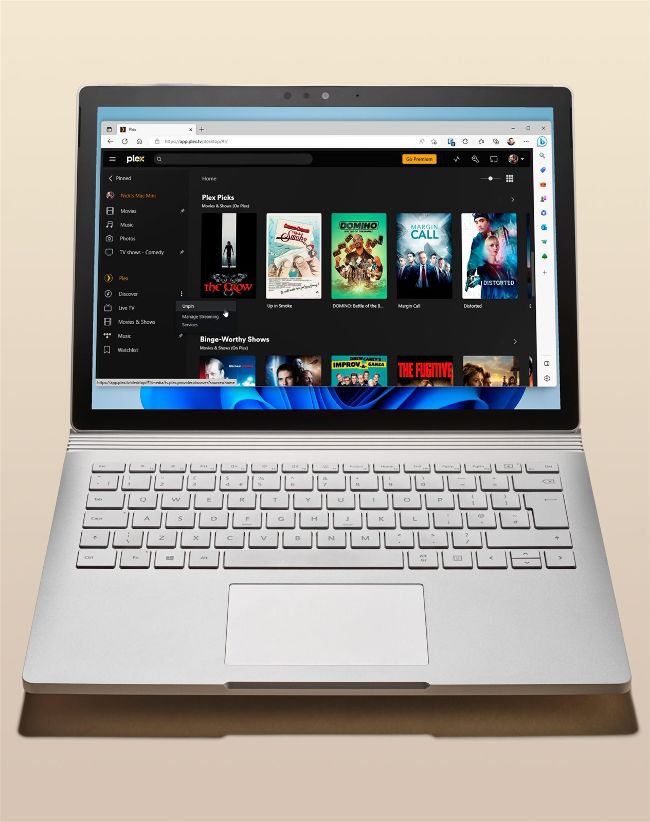media server
BUILD A KILLER MEDIA SERVER
Nick Peers reveals how to take control of your media and build your own always-on streaming library

You can easily remove Plex’s own content by unpinning it.
© PLEX
WHERE DO WE START with the problems of streaming services? Aside from the fact that they’ve proliferated in recent years as content increasingly gets siloed behind another expensive paywall, there’s no guarantee that the show you’re watching today will be available to stream tomorrow, never mind in the months ahead as complicated license rights shift from one platform to another.
The solution—as it always is—lies in owning your own content. Thanks to media servers like Plex and Jellyfin, you can make your own media library as accessible and easy to stream as any subscription-based streamer, with your content on tap 24-7 wherever you happen to be, and on whatever device you have to hand.
On the surface, setting up your media server is quite simple, but there are some considerations you need to make about where you host your server, plus how you package your content so it’s easily playable. In this feature, we’ll not only show you how to quickly set up and populate your own Plex server, we’ll reveal the tips and tricks you need to ensure your content streams on any device without bringing your server grinding to a halt. Turn the page to find out how.
LET’S START with a quick examination of the hardware you’re planning to use for your media server. While your main PC can effortlessly handle its relatively modest requirements, it’s far more efficient to offload it to a low-powered device—one that can run 24-7 without racking up huge electricity bills. Once again, we point you towards our mini-NAS build from the September 2022 issue, but you could also use an old laptop that has been gathering dust somewhere.
In terms of hardware requirements, your media server must handle the organization of your library, plus distribute media streams to whichever devices require it. If you live in a big household or share your library with others, you might find it having to handle as many as 4-5 streams simultaneously on occasion.
How much effort each stream requires depends on the media file, and whether it’s compatible with the playback device. The box reveals the different ways your media server can stream files, from the golden standard of ‘direct play’ to ‘transcoding’, where the file has to be converted on the fly to make it compatible.
In an ideal world, transcodes are few and far between—if you follow our advice later in this feature, you’ll produce video and audio files that should direct-play on most devices. However, even when an apparently perfect file is being served up, there may be times when transcoding is required, often as a result of available network or internet bandwidth.
In these circumstances, a lowpowered CPU like the Pentium J4125B or J5040 may struggle with two or more simultaneous transcodes. However, there’s a potential ace up your processor’s sleeve in the form of its GPU. Transcoding can be offloaded to the GPU, which makes short work of the task and allows you to perform many more transcodes without bringing your server grinding to a halt. You don’t need a top-end GPU—for example, Intel’s onboard graphics have long featured support for hardware transcoding through ‘Quick Sync Video’. However, while QSV has been available since the days of Sandy Bridge processors, good-quality hardware transcodes didn’t appear until 2016, and the emergence of processors sporting HD Graphics 600 or later. The equivalent technologies for other manufacturers are NVENC for NVIDIA (again, later generations— Turing onwards—produce better results), and AMF for AMD.
There’s one fly in the ointment: the free version of Plex doesn’t support GPU transcoding, so if you are planning to share your server widely, you’ll need to consider investing in the Plex Pass. GPU transcoding is just one of many features hidden behind a paywall. These include access from a mobile device (you can, however, pay a one-off fee for the mobile app if you prefer), the ability to watch and record live TV through your Plex server, and lots of little benefits, like access to historic stats on the Plex Dashboard, so you don’t just see who’s currently playing content on your server, but have access to stats revealing what’s been watched, by whom, and when.